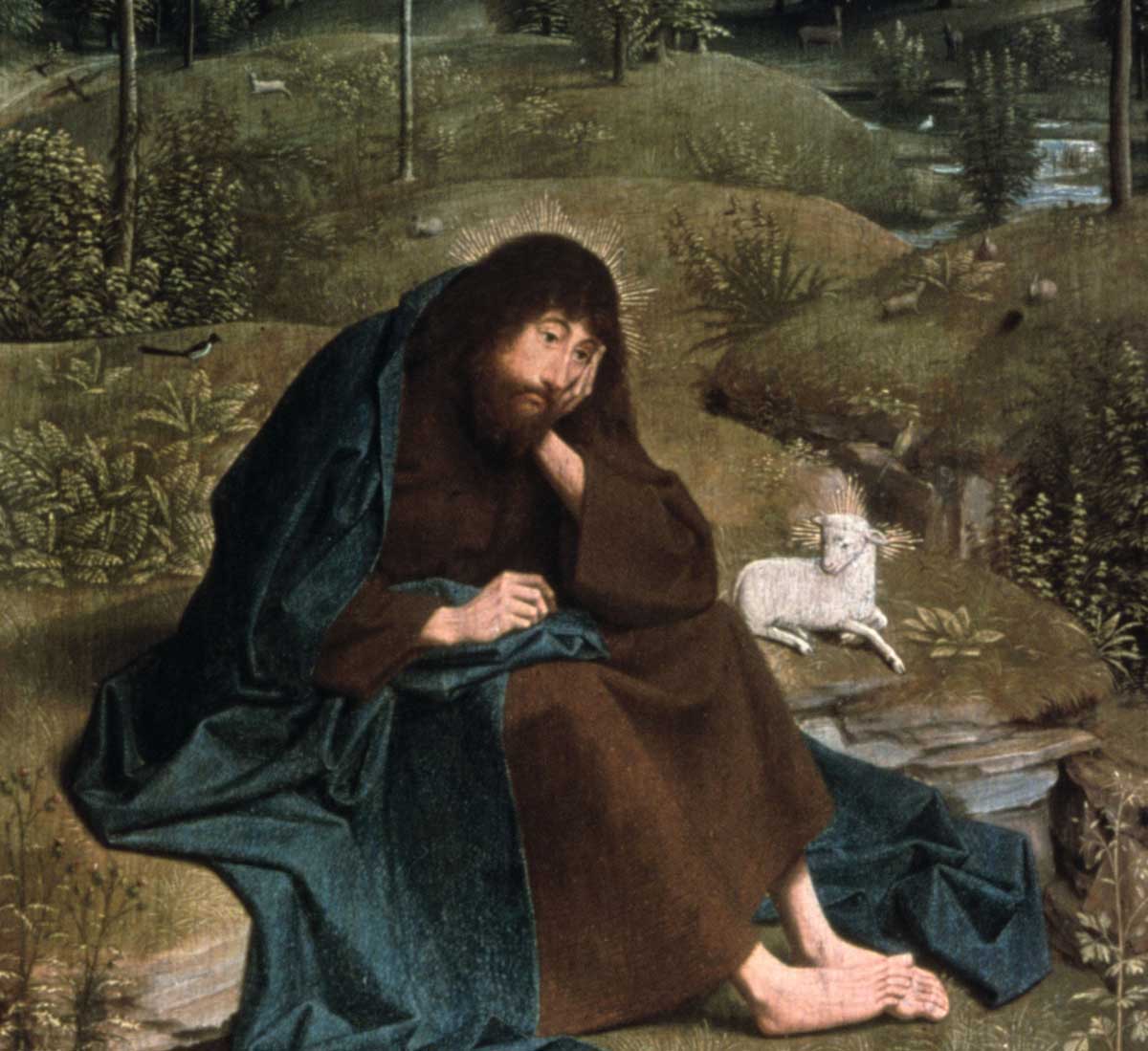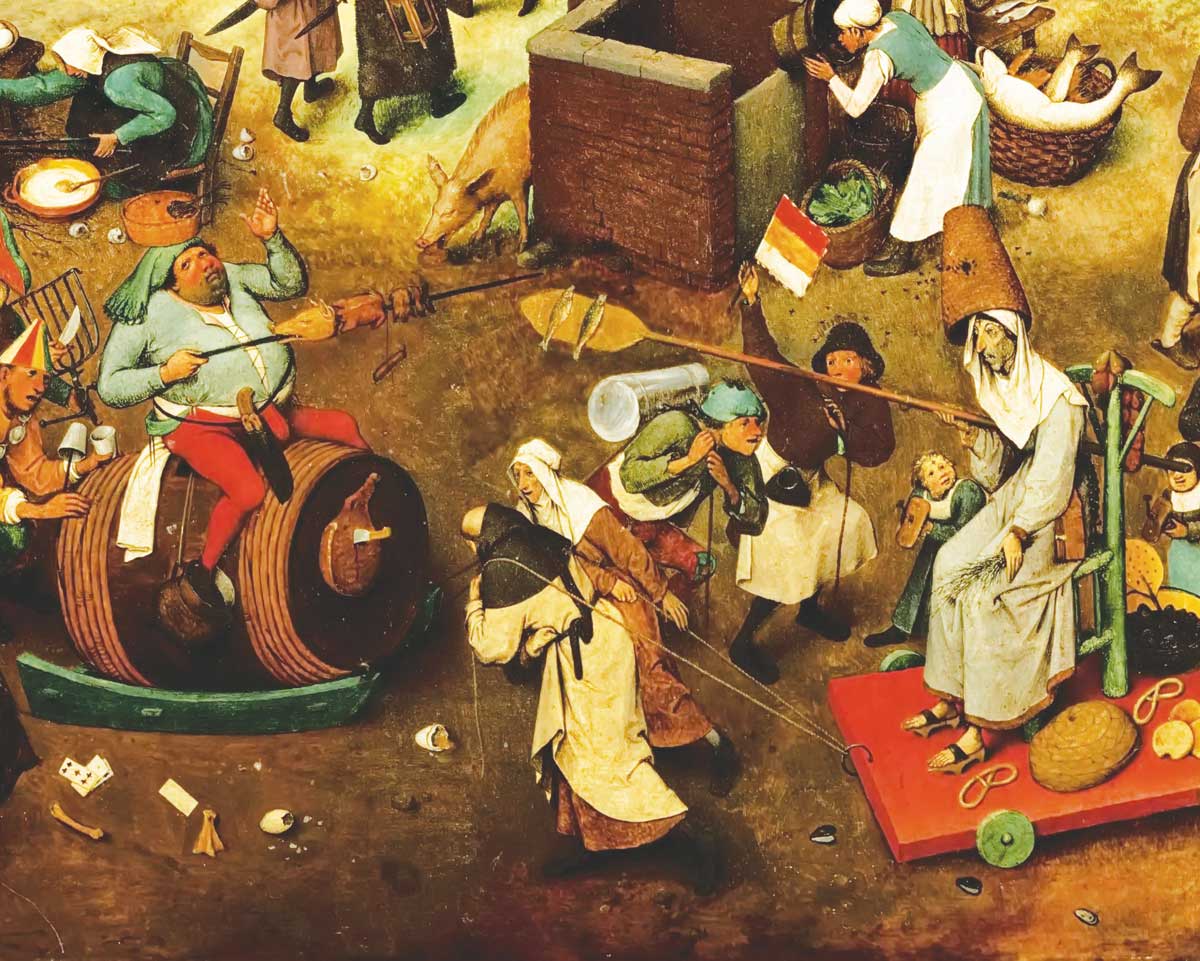Feature
Surprised by Awe
C. S. Lewis & Rudolf Otto’s The Idea of the Holy
In June 1962, The Christian Century sent C. S. Lewis a questionnaire asking him what books most influenced his “vocational attitude” and philosophy of life. Lewis politely answered with a list that included: Phantastes by George MacDonald, The Everlasting Man by G. K. Chesterton, The Aeneid by Virgil, The Temple by George Herbert, The Prelude by William Wordsworth, The Consolation of Philosophy by Boethius, The Life of Samuel Johnson by James Boswell, Descent into Hell by Charles Williams, Theism and Humanism by Arthur James Balfour, and Das Heilige by Rudolf Otto.
Readers of Lewis, especially those familiar with his 1955 autobiography, Surprised by Joy, will recognize most of these titles and understand their importance to Lewis. Indeed, it is likely that many readers came to their own knowledge of writers like MacDonald, Chesterton, and Williams through reading what Lewis had to say about them.
One exception might be the German theologian Rudolf Otto. Lewis wrote to Sister Madeleva in 1934: “I shd. warn you that I am very bad at German and this doubtless influenced my choice of reading.” Thus, even for a man known to be, as George Musacchio commented in C. S. Lewis, Man & Writer, always “reading, reading, reading,” Otto’s Das Heilige, or The Idea of the Holy, might be a surprising item on the Christian Century list.
Nevertheless, we know that Lewis read this work in the late 1920s, and that its effect on him was lasting, for in a letter he wrote to Corbin Scott Carnell thirty years later, he commented, “Otto’s Das Heilige I have been deeply influenced by.” In his own book on Lewis, Bright Shadow of Reality, Carnell mentions that Otto’s work, with Chesterton’s The Everlasting Man, “were two books whose influence on him seemed to increase with time.” Indeed, it is likely that Lewis read Das Heilige several times, for, as he wrote to his friend Arthur Greeves, “I can’t imagine a man really enjoying a book and reading it only once.”
Who was Rudolf Otto and what did he have to say that so conquered C. S. Lewis?
Otto’s Background
Otto was a physically frail man, and spent most of his adult life fighting sickness. He never married, but devotedly cared for his widowed sister and her young daughter all his life. His father died when he was thirteen, after the family had just moved to Hildesheim. They were originally from Peine in the Prussian province of Hannover, where Rudolf was born on September 25, 1869. His father’s malt business supported the family.
After attending the Gymnasium Andreanum at Hildesheim, Rudolf enrolled in the school of theology at the University of Erlangen, which was known for its conservatism. He eventually attended the more liberal school of theology at the University of Göttingen, where in 1895 he was awarded a Licentiate of Theology, the equivalent of a Ph.D., having written a dissertation on the Holy Spirit in Luther’s thought.
He taught systematic theology and the history and philosophy of religion at Göttingen until about 1914, at which time he went first to Breslau and then to Marburg. He occupied the official chair of theology in both universities, and stayed at the latter until he became professor emeritus in 1921. He died in 1937 from pneumonia, a complication resulting from a fall from a tower at Stauffenberg, near Marburg. Scholars are divided as to whether this was an attempted suicide or simply a tragic accident.
Twice during his lifetime, Otto went on a world tour, in 1911–1912 and again in 1927–1928. Among the places he visited were North Africa, Egypt, Palestine, India, China, and Japan. His interest in other religions, especially Hinduism, was influenced by these visits. Two series of lectures he delivered—the Haskell Lectures at Oberlin College in Ohio in 1924, on “Mysticism East and West”; and the Olaus Petri Lectures in Uppsala, Sweden, in 1926, on “India’s Religion of Grace and Christianity”—reflected this interest. Both sets of lectures were later turned into books.
In Surprised by Joy Lewis wrote:
The God whom I had at last acknowledged was one and was righteous. . . . Where was the thing full grown? . . . There were really only two answers possible: either in Hinduism or in Christianity. Everything else was either a preparation for, or else . . . a vulgarization, of these. Whatever you could find elsewhere you could find better in one of these.
These thoughts were possibly influenced by Otto’s writing on Eastern mysticism.
Beyond the Rational
Written in 1917 in German, Das Heilige was Otto’s first and most famous book. It framed all of his future writings. It was also a great success, running rapidly into several editions and being translated into many languages, including Japanese. It apparently spoke to the disillusioned, “lost generation” of World War I.
Otto began Das Heilige by making a distinction between rational and non-rational conceptions of God. He believed that the Deity was more than just a rational deduction, and something distinct from the world of science. He also thought that equating the holy with the moral good was not accurate enough, because the holy is a living force quite distinct from the good.
Otto coined the term “numinous” to designate the non-rational part of religious experience. By it, he meant the blissful exultation one experiences when contemplating the divine. Lewis describes such an experience in The Lion, the Witch and the Wardrobe, when he relates how the Pevensie children reacted when Mr. Beaver told them that Aslan was on the move: “At the name of Aslan each one of the children felt something jump in his inside.”
None of the children knew who Aslan was . . . but the moment the Beaver had spoken these words everyone felt quite different. Perhaps it has sometimes happened to you in a dream that someone says something which you don’t understand but in the dream it feels as if it had some enormous meaning . . . so beautiful that you remember it all your life.
Otto’s exposition of the numinous is his most important contribution to man’s understanding of his religious experience, or his experience of God. Chapters II, III, and IV of Das Heilige are pivotal in this regard, for in them he provides his description of the numinous, his explanation of the elements of the numinous, and finally, a discussion of what he calls the Mysterium Tremendum.
Filled with Awe
The numinous is a primary datum, meaning that it cannot be taught but can only be awakened in the mind. In fact, Otto begins his chapter “The Elements of the ‘Numinous’” with an admonition: “The reader is invited to direct his mind to a moment of deeply felt religious experience. . . . Whoever cannot do this, whoever knows no such moments in his experience, is requested to read no farther.”
But experiences of the numinous are not restricted to Christians or adherents of other established religions; in fact, in the later chapters of Das Heilige, Otto gives a history of the numinous in other contexts, such as magic, the worship of the dead, and the power of natural phenomena like volcanoes and eclipses. His thirteen appendices show the variety of numinous experience by discussing, among other things: the ideas of Chrysostom on the inconceivable in God; mystical elements in Martin Luther’s conception of faith; numinous experiences of John Ruskin; and expressions of the Mysterium Tremendum in a sermon of F. W. Robertson and a hymn of Isaac Watts.
But however experienced, the numinous involves an encounter with something objective and outside the self. Although the experience may be described in terms of emotion—as when Otto himself describes it as “the emotion of a creature, submerged and overwhelmed by his own nothingness in contrast to that which is supreme above all creatures”—the object of that experience, the numen, is itself wholly other. Lewis explains this in an essay in God in the Dock:
I still think Otto’s account of the Numinous is the best analysis of them [religious experiences] we have. I believe it is a mistake to regard the Numinous as merely an affair of “feeling.” Admittedly, Otto can describe it only by referring to the emotions it arouses in us; but then nothing can be described except in terms of its effects in consciousness. We have in English an exact name for the emotion aroused by the numinous, which Otto, writing in German, lacked; we have the word Awe.
Otto describes the element of “awfulness,” that is, being full of awe, as a holy fear of the Lord, one of the seven gifts of the Holy Ghost, along with wisdom, understanding, counsel, fortitude, knowledge, and piety. It is what is meant by the phrase from Proverbs 9:10, “The fear of the Lord is the beginning of Wisdom.” It is also what Moses experienced it in Exodus 3:5, when he was told, “Remove the sandals from your feet, for the place where you stand is holy ground.”
In Christian worship, according to Otto, this awe is expressed by the words, “Holy, holy, holy, Lord God of power and might, heaven and earth are full of your glory”; and in the awe-inspiring words of the Gloria: “For you alone are the Holy One, you alone are the Lord, you alone are the Most High.”
A Goal, Not a Road
Otto makes a distinction between this sense of awe and a sense of dependence that can also be aroused by an experience of the numinous. In this regard, he has some disagreements with Friedrich Schleiermacher, a nineteenth-century German theologian who is regarded by many as the father of modern Protestant thought. Schleiermacher defined religion as an intuition of the universe, and Christianity as a personal feeling of dependence on God. Otto responds: “Schleiermacher has the credit of isolating a very important element in such an experience. This is the ‘feeling of dependence.’ But this important discovery of Schleiermacher is open to criticism in more than one respect.”
For Otto, the fundamental element that goes beyond trust and love and that occupies the mind with a bewildering strength is what he calls the “Mysterium Tremendum.” It is what John in C. S. Lewis’s The Pilgrim’s Regress experiences when he responds to the strong voice that says, “Come”:
While he strained to grasp it, there came to him from beyond the wood a sweetness and a pang so piercing that instantly he forgot his father’s house, and his mother, and the fear of the Landlord, and the burden of the rules.
This Mysterium Tremendum is an inexpressible mystery, beyond our conception or understanding, something extraordinary and unfamiliar. If something escapes our understanding only for a time, it is not considered a “mystery” but rather a “problem,” something that eventually can be understood and solved. On the other hand, Otto explains, “mysterium means wholly other,” that which is beyond our sphere, beyond the intelligible, and beyond the familiar.
It is also something that captivates. Otto wrote that
the divine is indeed the highest, strongest, best, loveliest, and dearest that man can think of . . . God is not merely the ground and superlative of all that can be thought; He is Himself a subject on his own account and in Himself.
Thus, the numen is the object of religious search. An individual seeks communion with the numen, not for any benefit to himself, but simply for its own sake. “I know perfectly well,” Lewis wrote in A Grief Observed, “that He can’t be used as a road. If you’re approaching Him not as a goal but as a road, not as the end but as a means, you’re not really approaching Him at all.”
Sublime & Profane
In Chapter VII, “Analogies and Associated Feelings,” Otto explains what he means by the word “sublime”: “A thing does not become sublime merely by being great . . . it has in it something mysterious, and in this it is like the numinous.” What immediately comes to mind is Lewis’s explanation of the description of a waterfall as “sublime” in The Abolition of Man: “The feelings which make a man call an object sublime are not sublime feelings but feelings of veneration.”
In an encounter with the sublime, one experiences a feeling of his own absolute profaneness. We see this in Scripture when St. Peter says to Jesus, “Depart from me, for I am a sinful man, O Lord” (Luke 5:8), or when Isaiah says, “I am a man of unclean lips and dwell among a people of unclean lips” (Is. 6:5). Thus, an encounter with the numinous includes a recognition that one must somehow be purified—as Isaiah was with the burning coal—or clothed with the “wedding garment.”
This sense of unworthiness and of the need for purification is not just a gesture of humility but a component of the absolute awe one feels in the presence of the holy. Certainly, the centurion of Capernaum understood this when he said to Jesus, “I am not worthy that thou shouldst come under my roof” (Matt. 8:8). Such experiences of the numinous abound in both the Old and New Testaments.
But one cannot be taught this sense of awe. “If a man does not feel what the numinous is, when he reads the sixth chapter of Isaiah, then no ‘preaching, singing, telling,’ in Luther’s phrase, can avail him,” Otto writes. But it can be experienced in numerous contexts, he continues, including in miracles, art, literature, beautiful cathedrals, and music, such as Bach’s Mass in B minor. The mysterium is also profoundly encountered in Christian liturgies—as at the moment of Transubstantiation in the Roman Catholic Mass or in the half-concealed elements of the Eastern Orthodox liturgy.
Deepening the Rational
Indeed, Otto maintains that the numinous is found more in Catholic religious practices than in Catholic doctrine, for he claims that Catholic orthodoxy was subjected to a strong rationalizing influence through Aristotle and Thomas Aquinas. (However, it is also said that after Aquinas finished the Summa, he experienced the presence of the Almighty with such awe that he was never able to write another word.)
For his part, Lewis wrote to Carnell in 1958: “Aquinas and I were, in fact, at the same school—I don’t say in the same class! And I have read the Ethics long before I ever worked at the Summa.” Yet, Carnell goes on to note that “Lewis also acknowledges the necessity of balancing and guiding one’s rational conclusions by . . . intuitive insights.”
Martin Luther, on the other hand, was influenced by Duns Scotus’s non-rational elements in his understanding of God. Thus, in the Medieval debate between Aquinas and Scotus, Luther was closer to the position taken by Scotus because he grasped the problem of the non-rational in the idea of God.
Yet, as Otto notes in Chapter XIII, the rational cannot be totally dispensed with. The holy or the sacred is not merely numinous but must also be permeated with elements of rationality. “This permeation of the rational with the non-rational is to lead, then, to the deepening of our rational conception of God; it must not be a means of blurring or diminishing it.”
A Long Way Back
Lewis’s first encounter with the numinous may have come years before he ever heard of or read Otto’s book: while he was yet a boy, a feeling of Sehnsucht, or deep longing, was awakened in him by a toy garden his brother made for him in the lid of a biscuit tin. He later wrote in Surprised by Joy: “As long as I live my imagination of Paradise will retain something of my brother’s toy garden.”
Lewis also commented in The Problem of Pain: “What is certain is that now, at any rate, the numinous experience exists and that if we start from ourselves we can trace it a long way back.”
A beautiful modern example may be found (if we are not too proud to see it there) in chapter 7 of Kenneth Grahame’s The Wind in the Willows, where Rat and Mole approach Pan on the river island. Perhaps the long way back for most of us would begin with our own childhood recollections of the same “Piper at the Gates of Dawn”:
“This is the place of my song-dream, the place the music played to me,” whispered the Rat, as if in a trance. “Here in this holy place, here if anywhere, surely we shall find Him!”
Then suddenly the Mole felt a great Awe fall upon him, an awe that turned his muscles to water, bowed his head, and rooted his feet to the ground. It was no panic terror—indeed he felt wonderfully at peace and happy—but . . . he knew it could only mean that some august Presence was very, very near. . . .
“Rat!” he found breath to whisper, shaking. “Are you afraid?”
“Afraid?” murmured the Rat, his eyes shining with unutterable love. “Afraid! Of Him? O, never, never! And yet—and yet—O, Mole, I am afraid!”
Then the two animals, crouching to the earth, bowed their heads and did worship.
In addition to the works cited in the text, the author also consulted: William Griffin, Clive Staples Lewis: A Dramatic Life (Harper & Row, 1986); The Letters of C. S. Lewis to Arthur Greeves (1914–1963) (Macmillan, 1979); and Letters of C. S. Lewis (Harcourt Brace & Co., 1993).
Clara Sarrocco is the longtime secretary of The New York C. S. Lewis Society. She has taught classes on C. S. Lewis at the Institute for Religious Studies at St. Joseph's Seminary and is the president of the Long Island Chapter of University Faculty for Life. Her articles and reviews have appeared in numerous publications, including Touchstone, New Oxford Review, Gilbert, The Chesterton Review, St. Austin's Review, and The International Philosophical Quarterly.
subscription options
Order
Print/Online Subscription

Get six issues (one year) of Touchstone PLUS full online access including pdf downloads for only $39.95. That's only $3.34 per month!
Order
Online Only
Subscription

Get a one-year full-access subscription to the Touchstone online archives for only $19.95. That's only $1.66 per month!
bulk subscriptions
Order Touchstone subscriptions in bulk and save $10 per sub! Each subscription includes 6 issues of Touchstone plus full online access to touchstonemag.com—including archives, videos, and pdf downloads of recent issues for only $29.95 each! Great for churches or study groups.
Transactions will be processed on a secure server.
more on C. S. Lewis from the online archives
more from the online archives
calling all readers
Please Donate
"There are magazines worth reading but few worth saving . . . Touchstone is just such a magazine."
—Alice von Hildebrand
"Here we do not concede one square millimeter of territory to falsehood, folly, contemporary sentimentality, or fashion. We speak the truth, and let God be our judge. . . . Touchstone is the one committedly Christian conservative journal."
—Anthony Esolen, Touchstone senior editor













